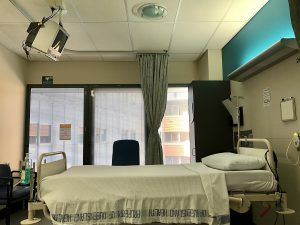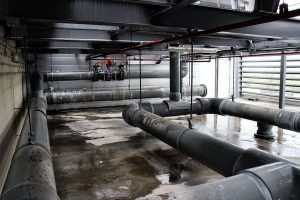Another quick post here. “Severe acute respiratory syndrome coronavirus 2 RNA contamination of inanimate surfaces and virus viability in a health care emergency unit.” One of several studies that have found the presence of viral RNA in a healthcare setting, but who were unable to culture virus from surfaces there. Abstract below: Objectives To detect …
Just a quick one here… a study looking for viral RNA in an intensively cleaned healthcare study showing very little detectable RNA in shared spaces in the hospital (in contrast to patient areas). No viral culturing which is pretty normal for these short notes. “Lack of SARS-CoV-2 RNA environmental contamination in a tertiary referral hospital …
This one from our collaborators at the University of Oregon, “Identification of SARS-CoV-2 RNA in Healthcare Heating, Ventilation, and Air Conditioning Units“. In this work they swabbed a bunch of locations on various air handlers in a healthcare setting and looked for SARS-CoV-2… finding it in about 25% of swabs. Most potentially worrying is the …
(h/t to Linsey Marr for posting this on Twitter) Another, more comprehensive, environmental sampling survey for SARS-CoV-2 from a hospital… this time in Wuhan, China. “Aerosol and Surface Distribution of Severe Acute Respiratory Syndrome Coronavirus 2 in Hospital Wards, Wuhan, China, 2020“. The authors here did air as well as surface sampling. Again, only RNA …
Another quick COVID19 Journal club in the Built Environment. This study (“Detection of Air and Surface Contamination by Severe Acute Respiratory Syndrome Coronavirus 2 (SARS-CoV-2) in Hospital Rooms of Infected Patients” combined air and surface sampling to look at the distribution of the virus in a healthcare setting with infected patients. This is another RNA-based …
A preprint came out yesterday entitled “Transmission Potential of SARS-CoV-2 in Viral Shedding Observed at the University of Nebraska Medical Center“. They looked at actual virus shed by patients in a healthcare setting (as opposed to artificial virus aerosols). They found widespread contamination of surfaces and objects in the room… but all of the detection …
Microbes indoors How do we make indoor environments and healthcare settings healthier? – Jack A. Gilbert – Microbial Biotechnology (OA) It is now well accepted that our modern lifestyle has certain implications for our health (Schaub et al., 2006), mainly as a result of our willingness to remove ourselves from the biological diversity of our …
Just discovered this site from the CDC dedicated to information about Helthcare Associated Infections: Healthcare-associated infections | HAI | CDC. It has a great collection of links and resources including links to data, research, prevention methods, and more. Definitely worth checking out if you have any interest in HAIs or hospital associated microbes.
A recent microbe.net post discussed the use of copper as an antimicrobial to prevent infections in healthcare settings. This is not a particularly new concept, but unfortunately, the literature appears dominated by authors who received funding from the copper industry and its associations. Such industrial funding is not unique to copper and is, sadly, more …
Building Information Research Knowldgebase – BRIK is a useful site for all kinds of architecture-oriented research. Here’s a link to the database of built environment research hosted by AIA with NIBS: http://www.brikbase.org/. Self-described as “your information portal to professionally reviewed research in the built environment for professionals by professionals” Here is an example of a …

